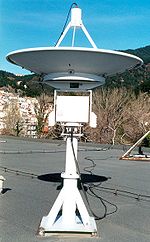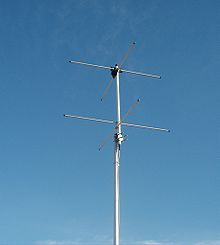- Weather satellite
-
The weather satellite is a type of satellite that is primarily used to monitor the weather and climate of the Earth. Satellites can be either polar orbiting, seeing the same swath of the Earth every 12 hours, or geostationary, hovering over the same spot on Earth by orbiting over the equator while moving at the speed of the Earth's rotation.[1] These meteorological satellites, however, see more than clouds and cloud systems. City lights, fires, effects of pollution, auroras, sand and dust storms, snow cover, ice mapping, boundaries of ocean currents, energy flows, etc., and other types of environmental information are collected using weather satellites. Weather satellite images helped in monitoring the volcanic ash cloud from Mount St. Helens and activity from other volcanoes such as Mount Etna.[2] Smoke from fires in the western United States such as Colorado and Utah have also been monitored.
Other environmental satellites can detect changes in the Earth's vegetation, sea state, ocean color, and ice fields. For example, the 2002 oil spill off the northwest coast of Spain was watched carefully by the European ENVISAT, which, though not a weather satellite, flies an instrument (ASAR) which can see changes in the sea surface.
El Niño and its effects on weather are monitored daily from satellite images. The Antarctic ozone hole is mapped from weather satellite data. Collectively, weather satellites flown by the U.S., Europe, India, China, Russia, and Japan provide nearly continuous observations for a global weather watch.
Contents
Observation
Observation is typically made via different 'channels' of the Electromagnetic spectrum, in particular, the Visible and Infrared portions.
Some of these channels include [3][4]:
- Visible and Near Infrared: 0.6 μm - 1.6 μm - For recording cloud cover during the day
- Infrared: 3.9 μm - 7.3 μm (Water Vapour), 8.7 μm, - 13.4 μm (Thermal imaging)
History
The first weather satellite, Vanguard 2, was launched on February 17, 1959. It was designed to measure cloud cover and resistance, but a poor axis of rotation kept it from collecting a notable amount of useful data.
The first weather satellite to be considered a success was TIROS-1, launched by NASA on 1 April 1960. TIROS operated for 78 days and proved to be much more successful than Vanguard 2. TIROS paved the way for the Nimbus program, whose technology and findings are the heritage of most of the Earth-observing satellites NASA and NOAA have launched since then.
Visible spectrum
Visible-light images from weather satellites during local daylight hours are easy to interpret even by the average person; clouds, cloud systems such as fronts and tropical storms, lakes, forests, mountains, snow ice, fires, and pollution such as smoke, smog, dust and haze are readily apparent. Even wind can be determined by cloud patterns, alignments and movement from successive photos.
Infrared spectrum
The thermal or infrared images recorded by sensors called scanning radiometers enable a trained analyst to determine cloud heights and types, to calculate land and surface water temperatures, and to locate ocean surface features. Infrared satellite imagery can be used effectively for tropical cyclones with a visible eye pattern, using the Dvorak technique, where the difference between the temperature of the warm eye and the surrounding cold cloud tops can be used to determine its intensity (colder cloud tops generally indicate a more intense storm).[5] Infrared pictures depict ocean eddies or vortices and map currents such as the Gulf Stream which are valuable to the shipping industry. Fishermen and farmers are interested in knowing land and water temperatures to protect their crops against frost or increase their catch from the sea. Even El Niño phenomena can be spotted. Using color-digitized techniques, the gray shaded thermal images can be converted to color for easier identification of desired information.
Types
There are two basic types of meteorological satellites: geostationary and polar orbiting.
Geostationary
"geostationary meteorological satellite" redirects here. For the Japanese satellites called "Geostationary Meteorological Satellite", see Himawari (satellite).Geostationary weather satellites orbit the Earth above the equator at altitudes of 35,880 km (22,300 miles). Because of this orbit, they remain stationary with respect to the rotating Earth and thus can record or transmit images of the entire hemisphere below continuously with their visible-light and infrared sensors. The news media use the geostationary photos in their daily weather presentation as single images or made into movie loops. These are also available on the city forecast pages of noaa.gov (example Dallas, TX).[6]
Several geostationary meteorological spacecraft are in operation. The United States has two in operation; GOES-11 and GOES-12. GOES-12, designated GOES-East, is located over the Amazon River[7] and provides most of the U.S. weather information. GOES-11 is GOES-West over the eastern Pacific Ocean. Russia's new-generation weather satellite Elektro-L 1 operates at 76°E over the Indian Ocean. The Japanese have one in operation; MTSAT-1R over the mid Pacific at 140°E. The Europeans have Meteosat-8 (3.5°W) and Meteosat-9 (0°) over the Atlantic Ocean and have Meteosat-6 (63°E) and Meteosat-7 (57.5°E) over the Indian Ocean. India also operates geostationary satellites called INSAT which carry instruments for meteorological purposes. China operated the Feng-Yun(風雲) geostationary satellites FY-2D at 86.5°E and FY-2E at 123.5°E, which are no longer in use.
Polar orbiting
Polar orbiting weather satellites circle the Earth at a typical altitude of 850 km (530 miles) in a north to south (or vice versa) path, passing over the poles in their continuous flight. Polar satellites are in sun-synchronous orbits, which means they are able to observe any place on Earth and will view every location twice each day with the same general lighting conditions due to the near-constant local solar time. Polar orbiting weather satellites offer a much better resolution than their geostationary counterparts due their closeness to the Earth.
The United States has the NOAA series of polar orbiting meteorological satellites, presently NOAA 17 and NOAA 18 as primary spacecraft, NOAA 15 and NOAA 16 as secondary spacecraft, NOAA 14 in standby, and NOAA 12. Europe has the Metop-A satellite. Russia has the Meteor and RESURS series of satellites. China has FY-1D and FY-3A. India has polar orbiting satellites as well.
DMSP
The United States Department of Defense's Meteorological Satellite (DMSP) can "see" the best of all weather vehicles with its ability to detect objects almost as 'small' as a huge oil tanker. In addition, of all the weather satellites in orbit, only DMSP can "see" at night in the visual. Some of the most spectacular photos have been recorded by the night visual sensor; city lights, volcanoes, fires, lightning, meteors, oil field burn-offs, as well as the Aurora Borealis and Aurora Australis have been captured by this 450-mile-high space vehicle's low moonlight sensor.
At the same time, energy monitoring as well as city growth can be accomplished since both major and even minor cities, as well as highway lights, are conspicuous. This informs astronomers of light pollution. The New York City Blackout of 1977 was captured by one of the night orbiter DMSP space vehicles.
In addition to monitoring city lights, these photos are a life saving asset in the detection and monitoring of fires. Not only do the satellites see the fires visually day and night, but the thermal and infrared scanners on board these weather satellites detect potential fire sources below the surface of the Earth where smoldering occurs. Once the fire is detected, the same weather satellites provide vital information about wind that could fan or spread the fires. These same cloud photos from space tell the firefighter when it will rain.
Dramatic photos are provided by all the weather satellites, but even more definitive were the DMSP night visible-light pictures of the 700 oil well fires that Iraq started on 23 February 1991 as they fled Kuwait. These fires were vividly illustrated as huge flashes in the night photos, far outstripping the glow of large populated areas. The fires consumed millions of gallons of oil; the last was doused on November 6.
Uses
Snowfield monitoring, especially in the Sierra Nevada, can be helpful to the hydrologist keeping track of how much snow is available for runoff vital to the water sheds of the western United States. This information is gleaned from existing satellites of all agencies of the U.S. government (in addition to local, on-the-ground measurements). Ice floes, packs and bergs can also be located and tracked from weather space craft.
Even pollution whether it's nature-made or man-made can be pinpointed. The visual and infrared photos show effects of pollution from their respective areas over the entire earth. Aircraft and rocket pollution, as well as condensation trails, can also be spotted. The ocean current and low level wind information gleaned from the space photos can help predict oceanic oil spill coverage and movement. Almost every summer, sand and dust from the Sahara Desert in Africa drifts across the equatorial regions of the Atlantic Ocean. GOES-EAST photos enable meteorologists to observe, track and forecast this sand cloud. In addition to reducing visibilities and causing respiratory problems, sand clouds suppress hurricane formation by modifying the solar radiation balance of the tropics. Other dust storms in Asia and mainland China are common and easy to spot and monitor, with recent examples of dust moving across the Pacific ocean and reaching North America.
In remote areas of the world with few local observers, fires could rage out of control for days or even weeks and consume millions of acres before authorities are alerted. Weather satellites can be a tremendous asset in such situations. Nighttime photos also show the burn-off in gas and oil fields.
See also
References
- ^ NESDIS. Satellites. Retrieved on 2008-07-04.
- ^ NOAA. NOAA Satellites, Scientists Monitor Mt. St. Helens for Possible Eruption. Retrieved on 2008-07-04.
- ^ EUMETSAT - MSG Spectrum (PDF)
- ^ EUMETSAT - MFG Payload
- ^ Chris Landsea. Subject: H1) What is the Dvorak technique and how is it used? Retrieved on 2009-01-03.
- ^ http://forecast.weather.gov/MapClick.php?lat=32.810361684869015&lon=-96.73736572265625&site=fwd&smap=1&marine=1&unit=0&lg=en
- ^ "GOES 12 Spacecraft Status Summary". NOAA Satellite and Information Service. http://www.oso.noaa.gov/goesstatus/spacecraftStatusSummary.asp?spacecraft=12. Retrieved December 13, 2010.
External links
- Theory
- Ralph E. Taggard (1994). Weather satellite handbook (5th edition). Newington, CT: American Radio Relay League. ISBN 0-87259-448-3.
- Cooperative Institute for Meteorological Satellite Studies
- Dr. Verner Suomi ("father of the geostationary satellite") biography
- Physical Characteristics of Geostationary and Polar-Orbiting weather satellites
- Data
- Near realtime composite of satellite image of the Earth by Intellicast
- International weather satellite viewer Online geostationary weather satellite viewer with 2 months of archived data.
- Earth at night by NASA
- EUMETSAT - the European Organisation for the Exploitation of Meteorological Satellites
Meteorological remote sensing systems in Earth orbit Concepts Defense Weather Satellite System · Earth observation satellite · Geographic information system (GIS) · Weather satelliteCurrent projects A-train satellitesOther satellitesCBERS · COSMIC (FORMOSAT-3) · COSMO-SkyMed · DMSP · DMC · Elektro-L · Envisat · EROS · ERS · Fengyun · FORMOSAT-2 · GOES · IKONOS · Landsat · MetOp · Meteor · Meteosat · MTSAT · NOAA-N' · QuickBird · RADARSAT-1 · RADARSAT-2 · SMOS · SPOT · TerraSAR-X · THEOSFormer projects CompletedFailedCategories:- Meteorological instrumentation and equipment
- Weather satellites
- Weather
Wikimedia Foundation. 2010.





